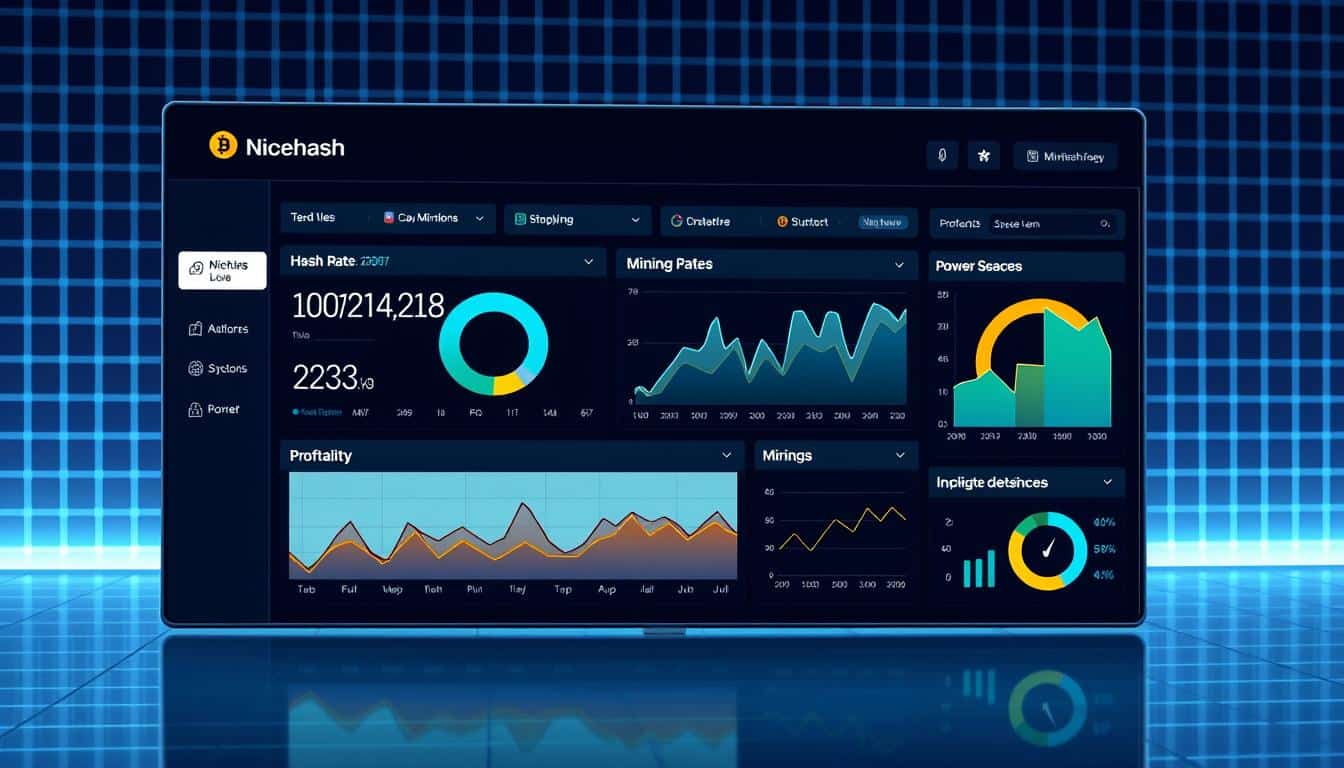Nicehash Bitcoin Mining Dashboard: Stats, Tools & Guide
Over 4.7 EH/s are active on the platform today — a scale that turns hobby rigs into a measurable part of the global network.
I built this guide to show exactly how I read the nicehash bitcoin mining dashboard, which tiles I watch, and the practical tools I lean on to improve results with less friction.
The dashboard combines monitoring, automatic overclocking, and profitability analytics. You’ll see how hashrate, efficiency, uptime, and device health map to real payouts.
I’ll set the stage for a graph I use: overlay real-time hashrate with earnings to spot drift fast. Everything here is evidence-forward and tied to sources in the data fields.
Key Takeaways
- Platform scale matters: 4.7 EH/s signals real adoption and liquidity.
- Core tiles — hashrate, efficiency, uptime — drive daily decisions.
- I use tools like auto-tuning and alerts to catch issues early.
- Fees and payout modes affect profitability; I explain RTPPS in plain terms.
- Sources and steps are cited inline so you can validate and adapt.
What the NiceHash dashboard is and why miners in the United States use it today
Here’s how the main view organizes data so you can act fast, even from your phone.
Who this is for: DIY operators and small-scale miners in the United States who want clear control without sitting at a computer all day.
The top tiles answer four fast questions: current and average hashrate, estimated earnings, payout status, and device health. Those lines feed alerts and watch lists so I see trouble before it becomes downtime.
Regulation matters for U.S. setups. The service is regulated in Switzerland and supports KYC, which helps when you need compliant workflows with banks, hosts, or buyers.
Practical steps: create an account, connect your hardware, and rigs start reporting. I use the built-in auto‑tuning and alerts to balance throughput and efficiency.
- Fast metrics: hashrate, payouts, uptime.
- Control features: watch lists, profitability tiles, and low‑fee partner options.
- Support: community guides, firmware notes, and account help for edge cases.
“Simple tiles up top, drill‑downs when needed — that clarity keeps me in control.”
Inside the nicehash bitcoin mining dashboard: core stats, real-time monitoring, and evidence
The view I watch pairs telemetry with revenue so I can act on real evidence fast. I keep that display simple: two live lines, a compact metric row, and alerts that force attention when something drifts.
Key metrics I track: instant hashrate, 24‑hour average, efficiency in W/TH, device temps, fan RPMs, and uptime by worker. These explain about 90% of short‑term performance changes.
Graph notes: I overlay real‑time hashrate and real‑time earnings in one chart. When hashrate holds but earnings fall, I suspect order demand or pool-side shifts. When both drop, I look at power and thermal limits first.
- RTPPS mechanics: every valid share earns immediately; payouts consolidate to your wallet every four hours.
- That four‑hour cadence makes reconciliation practical — I compare expected payouts to rig telemetry multiple times per day without constant checking.
- Evidence matters: a regulated operator in Switzerland with KYC and >4.7 EH/s on the platform gives strong marketplace confidence.
“Overlaying revenue and telemetry turned guesswork into a repeatable check for me.”
The built‑in suite of monitoring tools and alerts keeps the system honest. For mixed fleets I normalize to W/TH or W/MH so GPUs and asic boxes can be compared fairly.
Tools that boost results: NiceHash firmware, auto‑tuning, and a quick start guide
Firmware and auto‑tuning are the low‑effort upgrades that change day‑to‑day performance the most.
Real gains: official firmware can raise hashrate by up to 20% on specific machines and tighten efficiency to lower your power costs. I’ve seen the suite cut variability across boards so power draw matches the new profile.
Auto‑tuning: it runs per‑chip optimization so you choose raw performance or W/TH efficiency. Thermal guardrails and custom temperature targets keep hardware safe when ambient temps climb.
Supported models and range
- S19, S19 Pro, S19j Pro, S19j Pro+, S19 XP
- S21 Pro, S21 XP, T21
- L7, L9 and other scrypt machines
Quick start flashing guide
- Download firmware from the official Download Center.
- Run NiceHashTools on your subnet and scan for machines.
- Select targets, flash, then monitor first‑run stability for 10–15 minutes.
- Check hashrate ramp, board temps, fan behavior, and power draw.
“I re‑run auto‑tune after a cooldown when a board lags—most times a fresh pass evens out chip variance.”
Where to check compatibility: the official firmware page and download center list supported models and the latest software builds. Tag machines by model, stage profiles, and roll back quickly if a profile isn’t a fit.
Fees, payouts, and wallets: understanding RTPPS and the hashrate marketplace
RTPPS pays immediately for every valid share, then settles your balance to the wallet on a four‑hour cadence. That removes block‑luck variance you see with PPLNS and gives a smooth earnings line you can reconcile against hashrate.
Why that matters: predictable cash flow helps cover power bills and plan upgrades without guessing whether a block will clear.
RTPPS vs FPPS / PPLNS
I prefer RTPPS when I want steady payouts and clean accounting. FPPS gives fixed rewards including fees; PPLNS can spike but also drops unpredictably.
| Method | Payout timing | Predictability | Best use |
|---|---|---|---|
| RTPPS | Immediate per share; wallet updates every 4 hours | High | Stable cash flow, mixed GPU/ASIC fleets |
| FPPS | Frequent, includes block & fees | Moderate | Operators wanting fixed per‑share value |
| PPLNS | On block confirmation | Low (high variance) | Risk-tolerant setups aiming for occasional spikes |
| Notes | 4‑hour wallet cadence simplifies reconciliation | Tag workers to map payouts to rigs | Audit payouts after each period before changing profiles |
Current fee landscape and promotions
Short version: watch promos. I’ve seen the firmware service fee reduced to 0.6% when pointing at the platform pool (down from 1.4%), and 1.2% when pointing to other pools. Partner pricing for SMBs can cut fees further after you create an account.
Wallet setup, payout cadence, and U.S. considerations
Make your wallet plan simple. Enable security, confirm addresses, and separate working capital from long‑term holdings.
- Align withdrawals with U.S. banking windows to avoid timing gaps.
- Tag GPU and ASIC workers so you can map four‑hour payouts back to specific rigs when troubleshooting.
- Review four‑hour statements before changing profiles — change one variable at a time.
“I review four‑hour payouts, note any drift from expected earnings, and only then adjust profiles.”
Market dynamics and predictions: what to expect from NiceHash’s marketplace model
Buyer behavior right now is the clearest signal for near-term profit swings. Order depth and fee promos move payouts faster than changes in my rigs.
Short-term outlook: buyer demand, fee reductions, and profitability sensitivity
Short term: returns are most sensitive to how deep buyer orders are and to temporary fee cuts. When a promo drops the service fee to 0.6%, payouts per TH can rise quickly even if nothing about your rigs changed.
What I do: I time firmware rollouts and profile refreshes to ride promo windows. If demand softens, I flip profiles toward efficiency with auto-tuning to lower power costs before making bigger moves.
- Fee promos compress costs and lift earnings bands.
- Auto-tune is my first defense to recover margin on the fly.
- Watch order fills and global buyer behavior for early signals.
Medium-term view: how a global hashrate marketplace can stabilize and enhance payouts
Over months, a deeper buyer base should smooth volatility. Diverse use cases—testing, arbitrage, research—aren’t perfectly correlated with network luck, so fills should even out.
I model earnings bands tied to order depth and power costs. If the band slips below my threshold, I pivot to efficiency until price signals improve.
“Watch fees, watch demand, and keep tuning nimble; those three levers shape most day‑to‑day profitability outcomes in a marketplace model.”
- The marketplace creates a wider range of outcomes than static pools. That range is also where potential upside lives.
- ASIC models that tune well gain an operational edge—shift along the performance‑efficiency line as price moves.
- Globally smarter buyers will likely make fill rates steadier over time, improving the miner experience.
Conclusion
In closing, a simple rhythm of measure, tune, and verify keeps results steady.
I keep a short checklist: compare hashrate to payouts, confirm temps and power, then change one profile at a time and watch results. That routine scales from a single miner to a room of machines without drama.
Quick FAQ (U.S.): RTPPS settles to your wallet every four hours. KYC is supported and useful for compliant bank or host workflows. Firmware and per‑chip auto‑tuning can lift performance up to ~20% on supported models like S19, S21, L7, L9 and others; check the official firmware page for the latest list.
Fees move outcomes—watch promos (examples: 0.6% to the platform pool, 1.2% to other pools). Stay hooked into support and the community, secure your wallet and account, and keep the system simple: measure, tune, validate, repeat. That’s how you turn a control view into dependable profitability.





 Bitcoin
Bitcoin  Ethereum
Ethereum  Tether
Tether  XRP
XRP  USDC
USDC  TRON
TRON  Lido Staked Ether
Lido Staked Ether  Dogecoin
Dogecoin  Figure Heloc
Figure Heloc  Cardano
Cardano  WhiteBIT Coin
WhiteBIT Coin  Wrapped stETH
Wrapped stETH  Bitcoin Cash
Bitcoin Cash  Wrapped Bitcoin
Wrapped Bitcoin  USDS
USDS  Wrapped eETH
Wrapped eETH  Binance Bridged USDT (BNB Smart Chain)
Binance Bridged USDT (BNB Smart Chain)  Chainlink
Chainlink  Monero
Monero  LEO Token
LEO Token  WETH
WETH  Zcash
Zcash  Stellar
Stellar  Hyperliquid
Hyperliquid  Coinbase Wrapped BTC
Coinbase Wrapped BTC  Ethena USDe
Ethena USDe  Litecoin
Litecoin  Sui
Sui  Avalanche
Avalanche  Hedera
Hedera  sUSDS
sUSDS  USDT0
USDT0  Shiba Inu
Shiba Inu  Dai
Dai  Uniswap
Uniswap  PayPal USD
PayPal USD  Mantle
Mantle  Cronos
Cronos  World Liberty Financial
World Liberty Financial  Toncoin
Toncoin  Ethena Staked USDe
Ethena Staked USDe  Canton
Canton  Polkadot
Polkadot  USD1
USD1  Rain
Rain  Bitget Token
Bitget Token  Aave
Aave  MemeCore
MemeCore